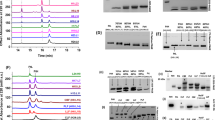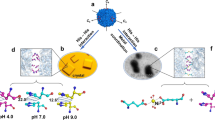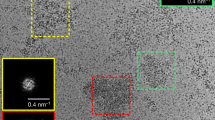Abstract
FERRITINis important in iron homeostasis. Its twenty-four chains of two types, H and L, assemble as a hollow shell providing an iron-storage cavity1–3. Ferritin molecules in cells containing high levels of iron tend to be rich in L chains, and may have a long-term storage function, whereas H-rich ferritins are more active in iron metabolism3–7. The molecular basis for the greater activity of H-rich ferritins has until now been obscure, largely because the structure of H-chain ferritin has remained unknown owing to the difficulties in obtaining crystals ordered enough for X-ray crys-tallographic analysis. Here we report the three-dimensional structure of a human ferritin H-chain homopolymer. By genetically engineering a change in the sequence of the intermolecular contact region, we obtained crystals isomorphous with the homologous rat L ferritin8–9 and of high enough quality for X-ray diffraction analysis. The X-ray structure of human H ferritin shows a novel metal site embedded within each of its four-helix bundles and we suggest that ferroxidase activity associated with this site accounts for its rapid uptake of iron10.
This is a preview of subscription content, access via your institution
Access options
Subscribe to this journal
Receive 51 print issues and online access
$199.00 per year
only $3.90 per issue
Buy this article
- Purchase on Springer Link
- Instant access to full article PDF
Prices may be subject to local taxes which are calculated during checkout
Similar content being viewed by others
References
Ford, G. C. et al. Phil. Trans. R. Soc. Lond. B304, 551–565 (1984).
Harrison, P. M. et al. in Biomineralisation: Chemical and Biochemical Perspective (eds. Mann, S., Webb, J. & Williams, R. J. P.) 257–294 (VCH Verlagsgesellschaft, Weinheim, 1989).
Arosio, P., Adelman, T. G. & Drysdale, J. W. J. biol. Chem. 253, 4451–4458 (1978).
Theil, E. C. A. Rev. Biochem. 56, 289–315 (1987).
Levi, S. et al. J. biol. Chem. 263, 18086–18092 (1988).
Arosio, P., Gatti, G. & Bolognesi, M. Biochim. biophys. Acta 774, 230–232 (1983).
Levi, S. et al. Biochemistry 28, 5179–5184 (1989).
Lawson, D. M., thesis, Sheffield Univ. (1990).
Thomas, C. D. et al. Biochem. Soc. Trans. 16, 838–839 (1988).
Lawson, D. M. et al. FEBS Lett. 254, 207–210 (1989).
Banyard, S. H., Stammers, D. K. & Harrison, P. M. Nature 271, 282–284 (1978).
Treffry, A., Harrison, P. M., Luzzago, A. & Cesareni, G. FEBS Lett. 247, 268–272 (1989).
Levi, S. et al. Biochem. J. 264, 381–388 (1989).
Bakker, G. R. & Boyer, R. F. J. biol. Chem. 261, 13182–13185 (1986).
Connolly, M. L. J. appl. Cryst. 16, 23–28 (1983).
Treffry, A. & Harrison, P. M. J. inorg. Biochem. 21, 9–20 (1984).
Bauminger, E. R., Harrison, P. M., Nowik, I. & Treffry, A. Biochemistry 25, 5486–5493 (1989).
Chasteen, N. D. & Theil, E. C. J. biol. Chem. 257, 7672–7677 (1982).
Stenkamp, R. E., Sieker, L. C. & Jensen, L. H. J. Am. Chem. Soc. 106, 618–622 (1984).
Sheriff, S., Hendrickson, W. A. & Smith, J. L. J. molec. Biol. 197, 273–296 (1987).
Nordlund, P., Sjöberg, B-M. & Eklund, H. Nature 345, 593–598 (1990).
Konnert, J. H. & Hendrickson, W. A. Acta crystallogr. A36, 344–350 (1980).
Fraser, R. D. B., MacRae, T. P. & Suzuki, E. J. appl. Cryst. 11, 693–694 (1978).
Boyd, D., Vecoli, C., Belcher, D. M., Jain, S. K. & Drysdale, J. W. J. biol. Chem. 260, 11755–11761 (1985).
Murray, M. J., White, K. & Munro, H. N. Proc. natn. Acad. Sci. U.S.A. 84, 7438–7442 (1987).
Stevens, P. W., Dodgson, J. B. & Engel, J. D. Molec. cell. Biol. 7, 1751–1758 (1987).
Dickey, L. F. et al. J. biol. Chem. 262, 7901–7907 (1987).
Leibold, E. A. & Munro, H. N. J. biol. Chem. 262, 7335–7341 (1987).
Heusterspreute, M. & Crichton, R. R. FEBS Letts 129, 322–327 (1981).
Daniels-McQueen, S. et al. Nucleic Acids Res. 16, 7741 (1988).
Author information
Authors and Affiliations
Rights and permissions
About this article
Cite this article
Lawson, D., Artymiuk, P., Yewdall, S. et al. Solving the structure of human H ferritin by genetically engineering intermolecular crystal contacts. Nature 349, 541–544 (1991). https://doi.org/10.1038/349541a0
Received:
Accepted:
Issue Date:
DOI: https://doi.org/10.1038/349541a0
This article is cited by
-
Identification of ferroptosis and drug resistance related hub genes to predict the prognosis in Hepatocellular Carcinoma
Scientific Reports (2023)
-
Agglomeration: when folded proteins clump together
Biophysical Reviews (2023)
-
Self-assembling ferritin-dendrimer nanoparticles for targeted delivery of nucleic acids to myeloid leukemia cells
Journal of Nanobiotechnology (2021)
-
Multivalency transforms SARS-CoV-2 antibodies into ultrapotent neutralizers
Nature Communications (2021)
-
Equi–size nesting of Platonic and Archimedean metal–organic polyhedra into a twin capsid
Nature Communications (2020)
Comments
By submitting a comment you agree to abide by our Terms and Community Guidelines. If you find something abusive or that does not comply with our terms or guidelines please flag it as inappropriate.



